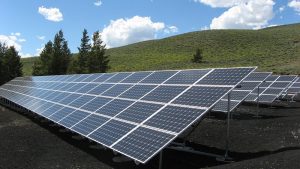The United Nations (UN) announced on October 8, 2018, that humanity has 12 years to prevent climate change from reaching irreversible levels that could lead to an environmental catastrophe that may affect millions of humans. In a landmark report by the UN Intergovernmental Panel on Climate Change (IPCC), drafted by 91 authors across 40 countries and based on 6,000 scientific references, humanity has 12 years to decrease climate change or else the temperature will go beyond 1.5 degrees Celsius, which could lead to floods, drought, extreme temperatures, and poverty.
The threat looms over us like an impending apocalypse. Yet, the United States — the biggest source of carbon pollution in history — continues to roll back climate measures for the benefit of industry giants. Even our own president refuses to believe the IPCC, claiming there were other reports saying the environment was in a “fabulous” condition.
 We do not need to keep providing industries with more leeway. While the everyday person could switch to reusable straws, eat less meat, and avoid one-use plastics, our attempts at becoming more green will all be for nothing 12 years from now if industrial giants don’t stop with the carbon emissions. And what’s very frustrating about all of this is that greener, alternative methods aren’t just a pipe dream anymore— they already exist, are available in the market, and offer so much potential at a greener production of goods for consumers.
We do not need to keep providing industries with more leeway. While the everyday person could switch to reusable straws, eat less meat, and avoid one-use plastics, our attempts at becoming more green will all be for nothing 12 years from now if industrial giants don’t stop with the carbon emissions. And what’s very frustrating about all of this is that greener, alternative methods aren’t just a pipe dream anymore— they already exist, are available in the market, and offer so much potential at a greener production of goods for consumers.
Solar energy, for example, has existed for almost 180 years yet we are only taking small steps toward renewable energy. We already have the technology to create drastic change, but we need that push towards alternative technology.
Debunking Solar Energy
While solar energy offers greener ways to power our daily needs and business operations, it, along with wind energy and other renewable energy sources, make up only three percent of the global energy capacity. The rest of the 97 percent go to non-renewable sources such as oil, coal, and natural gas — all of which are the main reason we have huge carbon emissions and are in this environmental dilemma in the first place.
Many people believe the misconception that solar energy is ineffective to carry the same weight as non-renewable energy because it cannot work at night or on cloudy days. While it is true you cannot harvest solar energy at night, throughout the day, solar panels store energy into batteries. Well-equipped solar energy systems have adequate batteries to power their operations even without sunlight. As for cloudy days, solar energy can still be absorbed as long as there is light. While systems need maximum sunlight for optimal performance, solar power can still function on less light.
Can We Power the World on Solar Energy Alone?
 Imagine how much climate change we can prevent by putting the entire world on solar power. Mehran Moalem, PhD, an expert on nuclear materials and nuclear fuel cycles, answered the question on whether or not it was possible for the entire world to survive on solar energy alone. According to him, the world would need 43,000 square miles of solar panels. The Great Saharan Desert, one of the hottest and most dry places in the world, was the ideal place to install solar panels. And with 3.6 million square miles of desert, only 1.2 percent of it would be covered in solar panels. That on its own could easily provide for the total world energy usage.
Imagine how much climate change we can prevent by putting the entire world on solar power. Mehran Moalem, PhD, an expert on nuclear materials and nuclear fuel cycles, answered the question on whether or not it was possible for the entire world to survive on solar energy alone. According to him, the world would need 43,000 square miles of solar panels. The Great Saharan Desert, one of the hottest and most dry places in the world, was the ideal place to install solar panels. And with 3.6 million square miles of desert, only 1.2 percent of it would be covered in solar panels. That on its own could easily provide for the total world energy usage.
It sounds like a fantasy, considering that a project such as this will cost the world about five trillion dollars for a one-time installation fee, but Moalem says it is possible. When you consider that all nations will be involved, it may be possible. The US is spending $892 billion on the military even though we are $21 trillion dollars in debt. Surely, they can divert some of those funds to help contribute to global solar power. And consider this: after paying to install solar panels and direct the energy to everyone in the world, we would never have to pay for people to dig for energy.
According to Moalem, this project will trump the need for other non-renewable energy sources. While there are other logistics to consider such as how fuel-operated cars will be converted into electric cars and actually getting that power from the Sahara to different parts of the world, Moalem poses that it is possible, and it is an idea we need to work on. The United States produces 1.7 million metric tons of carbon emissions, and total conversion could significantly reduce that.
The Benefits of Going Green
As of writing, no industries have volunteered to go green despite the UN’s announcement, while some governments are still “planning” to find greener methods. Maybe they think it is more cost-efficient to stay coal-powered or the costs of going green outweigh the profits. However, it is an investment in their operations, since they only have to pay for solar installation, as well as their public image.
 As for their public image, wouldn’t it look good if an industry giant took heed of the UN’s warning and publicly decided to go green? In a period where Millennials are starting to take over, corporations will want to consider going green. According to Nielsen, 75 percent of Millennials are more willing to buy a costlier product if it offers sustainability.
As for their public image, wouldn’t it look good if an industry giant took heed of the UN’s warning and publicly decided to go green? In a period where Millennials are starting to take over, corporations will want to consider going green. According to Nielsen, 75 percent of Millennials are more willing to buy a costlier product if it offers sustainability.
According to Nielsen Public Development & Sustainability Senior Vice President, Grace Farraj, brands that establish a reputation for environmental stewardship may attract a younger market. Their reputation can keep loyal Millennial customers to continue patronizing their brand. Only 75 percent of the millennial generation, yes, but that’s 75 percent of a $200 billion spending power in the market.
I would be lying if I said the switch to solar power would be cheap; a new power system will be an investment on corporations who switch. However, it is a switch worth making in terms of the environment, the corporation’s reputation with Millennials, and their finances. Surely, these industry giants with billions of dollars in profits every year could find it in their hearts and pockets to invest in alternative, greener technology. After all, only our planet and our environment as we know it are at stake.